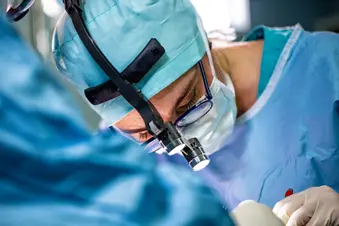
When you have obstructive sleep apnea (OSA), part of your upper airway narrows during slumber, cutting off oxygen supply. This disrupts sleep, so you never really get the rest you need.
Lifestyle changes, like losing extra weight and positional therapy, can ease symptoms. So can oral and dental appliances or positive airway pressure (PAP).
Surgery may be an option in some cases. It might help PAP or oral and dental appliances work better. Or it could curb symptoms enough that you don’t need other treatments.
How Does Surgery for Sleep Apnea Work?
Your doctor will likely do a sleep endoscopy first to see if surgery is an option for you. They’ll put a long, thin tube with a camera through your nose while you’re asleep (with the help of anesthesia) to see which areas are blocked or closing in.
Surgeries focus on different parts of your mouth or throat including the:
- Soft palate
- Uvula
- Tonsils
- Adenoids
- Tongue
Surgery might change the position of your jaw or straighten the soft tissue in your nose. Doctors that perform these procedures include:
- Ear, nose, and throat (ENT) surgeons
- Oral and maxillofacial surgeons
- Sleep surgeons
Surgeries for OSA include:
Uvulopalatopharyngoplasty. This procedure opens the airway by changing the shape of the soft tissue in your throat. All or part of your soft palate may be taken out. Your uvula (hangs at the back of your throat) and tonsils might go, too.
Before deciding to do this type of surgery, your doctor will consider:
- How well other treatment options are working, including PAP or weight loss
- How big your tonsils are
- How your soft palate sits in relation to your tongue
- Your body mass index (BMI)
Success rates depend on the person. Some studies found it could cut breathing events by about 30%. But the benefits of surgery may not last as your upper airway tissues or body weight change over time.
Tongue reduction. Along with uvulopalatopharyngoplasty, the surgeon may consider thinning your tongue muscles if your tongue is unusually thick. This can help keep it from falling back and blocking your airway while you’re asleep.
Lingual tonsillectomy. The procedure involves removing the lingual tonsils at the base of your tongue muscle. This surgery is more likely if an endoscopy shows they’re blocking your airway.
Hypoglossal nerve stimulation. The FDA approved this type of surgery in 2014. A surgeon implants a device that generates pulses and has stimulation and breathing sensor leads. The pulse generator stimulates a nerve that moves your tongue forward each time you breathe. It’s sometimes an option for adults who haven’t done well with PAP.
Maxillomandibular advancement. A surgeon moves the upper and lower jaw forward to widen your airway. While studies have shown this procedure can be very effective in treating OSA, it’s a lot less common than uvulopalatopharyngoplasty.
Tracheostomy. This involves cutting an opening in the neck in front of the windpipe to help you breathe freely. You’re not likely to have this surgery unless:
- Your OSA is severe.
- More traditional treatments have failed.
- You’re not a good fit for other types of surgery.
Adenoidectomy. Removal of the adenoids alone may be recommended for children with OSA. Particularly those with moderate OSA, small tonsils, and normal weight.
Sleep Apnea Surgery Risks
Any type of surgery comes with risks, including:
- Infection
- Bleeding
- Allergic reaction to anesthesia
The risks of surgery for OSA depends on which procedure you have. Some complications include:
- Scarring that tightens your airway, called nasopharyngeal stenosis.
- Trouble coordinating your soft palate and throat to swallow, called velopharyngeal insufficiency.
- Changes in the way your voice sounds.
Bariatric Surgery for Sleep Apnea
Bariatric surgery, also known as gastric bypass or weight loss surgery, changes your stomach and digestive system to encourage weight loss. It may be an option if you’re unable to slim down otherwise and have serious weight-related health problems.
One study found that many people who get bariatric surgery also have OSA. The surgery helped them lose weight, which eased OSA symptoms.
Questions to Ask Your Doctor
If other treatments haven’t worked and you’d like to consider surgery, here are some questions to ask:
- Should I consider sleep surgery for my apnea?
- How will surgery help?
- What type of surgery would you recommend?
- How much will surgery help my apnea?
- How long will it take to recover?
- Will surgery permanently improve my apnea?
- Should I consider bariatric surgery for weight loss and sleep apnea?
- Should I have a sleep endoscopy?
- If I have surgery, will I still need PAP or other sleep apnea treatments?
- What are the risks of surgery for my sleep apnea?
Show Sources
Photo Credit: iStock/Getty Images
SOURCES:
Mayo Clinic: “Sleep apnea,” “Bariatric surgery.”
University of Michigan Health: “Surgical Alternatives to CPAP.”
Cleveland Clinic Journal of Medicine: “Treatments for obstructive sleep apnea: CPAP and beyond.”
Cleveland Clinic: “Sleep Apnea,” “Uvulopalatopharyngoplasty (UPPP Surgery).”
MyHealth.Alberta.ca: “Sleep Apnea: Should I Have Surgery?”
Laryngoscope: “Tracheostomy as treatment for adult obstructive sleep apnea: a systematic review and meta-analysis.”
Journal of Clinical Sleep Medicine: “Adenoidectomy for Obstructive Sleep Apnea in Children.”
Medscape: “Sleep Endoscopy.”
University of Chicago Medicine: “Lingual Tonsillectomy for Obstructive Sleep Apnea.”
Journal of Minimal Access Surgery: “Impact of bariatric surgery on obstructive sleep apnoea–hypopnea syndrome in morbidly obese patients.”